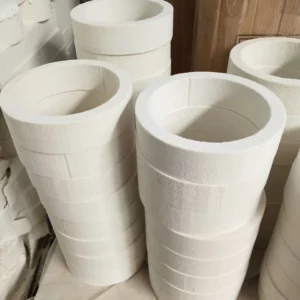China 1260C ceramic fiber vacuum molding can be used for what
China 1260℃ ceramic fiber vacuum molding, also known as vacuum-formed ceramic fiber, can be used in various high-temperature insulation applications.
Here are some common uses:
- Furnace and Kiln Linings: Vacuum-formed ceramic fiber can be used to line furnaces, kilns, and other high-temperature equipment. It provides excellent thermal insulation, reducing heat loss and improving energy efficiency in these industrial heating processes.
- Heat Treatment Applications: Ceramic fiber vacuum molding is suitable for heat treatment applications such as annealing, tempering, and quenching processes. It helps maintain consistent and controlled temperatures, ensuring proper heat treatment of materials.
- Foundries and Metal Processing: Vacuum-formed ceramic fiber is used in foundries and metal processing facilities to line crucibles, ladles, and other equipment used for melting and casting metals. It provides insulation, preventing heat loss and improving the efficiency of metal melting processes.
- Glass Industry: In the glass manufacturing industry, vacuum-formed ceramic fiber is utilized for lining glass melting furnaces, glass tanks, and other high-temperature equipment. It helps maintain stable operating temperatures and improves energy efficiency in the glass production process.
- Petrochemical Industry: Ceramic fiber vacuum molding finds application in the petrochemical industry, particularly in insulation for cracking furnaces, reformers, and other high-temperature equipment used in the production of chemicals and petroleum products.
- Power Generation: Vacuum-formed ceramic fiber can be used in power generation facilities, including boilers and thermal power plants. It provides insulation to reduce heat loss and improve the efficiency of power generation processes.
- Incinerators and Industrial Ovens: Ceramic fiber vacuum molding is suitable for lining incinerators, industrial ovens, and other thermal processing equipment. It helps retain heat, reduces energy consumption, and improves the overall efficiency of these systems.
- Automotive and Aerospace Industries: Vacuum-formed ceramic fiber is used in the automotive and aerospace industries for insulation in high-temperature applications. It can be found in exhaust systems, engine components, and other areas that require thermal insulation.
- Insulation for Building and Construction: Ceramic fiber vacuum molding can be used in building and construction projects as insulation for high-temperature applications. It provides thermal insulation in areas such as fireproofing, kiln linings, and industrial chimneys.
- Other Industrial Applications: Vacuum-formed ceramic fiber can find use in various other industrial applications, including thermal insulation for boilers, heat exchangers, and process piping, as well as in the production of high-temperature gaskets and seals.
It’s important to note that the specific application and suitability of ceramic fiber vacuum molding may depend on factors such as the thickness, density, China 1260C ceramic fiber vacuum formed manufacturer and composition of the material. Consulting with experts or suppliers in the field can provide more specific guidance on the appropriate use of China 1260℃ ceramic fiber vacuum molding for your particular application.
Here are some additional details about China 1260℃ ceramic fiber vacuum molding:
- Manufacturing Process: Ceramic fiber vacuum molding is produced through a specialized manufacturing process. Ceramic fiber blankets or boards are first cut and shaped to the desired dimensions. These preformed shapes are then placed in a vacuum chamber, where a vacuum is applied to remove air and create a tight, compact structure. The vacuum-formed shapes are then cured at high temperatures to strengthen the structure and improve its thermal properties.
- Thermal Insulation: China 1260℃ ceramic fiber vacuum molding offers excellent thermal insulation properties. It has low thermal conductivity, which means it minimizes heat transfer and provides effective insulation in high-temperature environments. This insulation capability helps to improve energy efficiency and temperature control in various industrial processes.
- Lightweight and Low Heat Storage: Ceramic fiber vacuum molding is lightweight compared to traditional refractory materials. Its low density makes it easier to handle and install. Additionally, it has low heat storage capacity, meaning it absorbs and retains less heat. This property allows for faster heating and cooling cycles, reducing energy consumption and improving process efficiency.
- High-Temperature Resistance: China 1260℃ ceramic fiber vacuum molding is designed to withstand temperatures up to 1260℃ (2300℉) without significant deformation or degradation. It maintains its structural integrity and insulation properties even at extreme temperatures, making it suitable for demanding high-temperature applications.
- Chemical Stability: Ceramic fiber vacuum molding exhibits good chemical stability and resistance to most chemicals, including acids, alkalis, and organic solvents. This chemical resistance allows it to maintain its performance and structural integrity when exposed to corrosive environments.
- Low Thermal Expansion: Ceramic fiber vacuum molding has low thermal expansion, meaning it expands very little when exposed to high temperatures. This property helps to minimize the risk of cracking or spalling, even during thermal cycling or rapid temperature changes.
- Customizable Shapes and Sizes: China 1260℃ ceramic fiber vacuum molding can be produced in various shapes and sizes to meet specific application requirements. It can be customized to fit complex geometries or specialized equipment, ensuring proper insulation coverage and installation.
- Fire Resistance: Ceramic fiber vacuum molding is highly fire-resistant and provides effective fire protection. It has a high melting point and does not contribute significantly to the spread or intensity of flames. This makes it suitable for applications where fire safety is a concern.
- Non-Asbestos: China 1260℃ ceramic fiber vacuum molding is typically non-asbestos, which means it does not contain asbestos fibers. This makes it a safer and healthier alternative to traditional asbestos-based insulation materials.
- Eco-Friendly: Ceramic fiber vacuum molding is considered an eco-friendly insulation material. It is manufactured using natural or synthetic fibers and does not emit harmful gases or substances during use. It also has a long service life, reducing the need for frequent replacement and minimizing waste.
When considering the use of China 1260℃ ceramic fiber vacuum molding, it’s important to consult with experts or suppliers who can provide guidance on its specific application, installation requirements, and compatibility with other materials in your industry or process.
